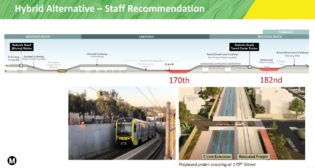
Trolleys without the trolley wire
Written by Lyndon HenryOff-wire light rail? Time was, not so long ago, that when I heard that phrase I immediately envisioned a light rail car that had accidentally got its trolley pole or pantograph off the overhead electric contact wire.
 Nowadays, of course, as many rail transit professionals and advocates know, “wireless” light rail transit (LRT) systems (especially slower-moving streetcar lines) with “off-wire” capability are all the rage, and the technology has advanced to make that commercially possible. The ability to design light rail systems partially or even totally free of the conventional overhead contact system (OCS, the technical term for the overhead wires) has afforded planners a significant new dimension of flexibility—as new systems in cities as diverse as Nice (pictured), Bordeaux, Dubai, and Dallas have been demonstrating.
Nowadays, of course, as many rail transit professionals and advocates know, “wireless” light rail transit (LRT) systems (especially slower-moving streetcar lines) with “off-wire” capability are all the rage, and the technology has advanced to make that commercially possible. The ability to design light rail systems partially or even totally free of the conventional overhead contact system (OCS, the technical term for the overhead wires) has afforded planners a significant new dimension of flexibility—as new systems in cities as diverse as Nice (pictured), Bordeaux, Dubai, and Dallas have been demonstrating.
Dual-power LRT systems (mostly electrically powered under wire, but able to run from onboard internal-combustion engine power over non-electrified segments) have operated in a handful of locations for several decades. However, the new “wire-free” systems are typically all-electric, and generally fall into two categories:
• External power provided beneath the railcar (rather than above it). Alstom’s APS (alimentation par sol, “ground power”) system is probably the most widely used example so far.
• Onboard Energy Storage (OES) systems. Most common are either battery-based or supercapacitor-based, although hydrogen fuel cell systems (which require an onboard tank of hydrogen gas) are also being offered.
As you might imagine, all these leading-edge “wire-free” technologies were hot topics of conversation, presentation and discussion at 13th National Light Rail Conference, co-sponsored by the American Public Transportation Association (APTA) and U.S. Transportation Research Board (TRB) in Minneapolis Nov. 15-17, 2015. As usual, some of the most enlightening news and insights came out of APTA’s Streetcar Subcommittee, which met Nov. 15, with “wire-free” developments a major focus.
For me, a key takeaway is that the working concept today mostly involves hybrid implementations of these new technological developments. OES (such as with batteries or supercaps) is often combined with sections fed by external power (OCS or ground-based).
Example: According to Mark Hill, director of business development for Alstom, a new 28-km/17-mile LRT system for Rio de Janeiro will be totally “wire-free”, powered by a combination of OES supercaps and Alstom’s proprietary APS (a central third rail between the running rails, energized only when a train passes over it). Hill cited a recharging time of as little as 20 seconds (from OCS at the recharging points). While APS installation is reported to cost more than OCS, Hill predicts that maintenance will be lower.
Another example is the new 1.6-mile streetcar line connecting downtown Dallas with the city’s Oak Cliff section on the west side of the wide Trinity River flood plain, using a venerable historic viaduct that officials wanted to keep “wire-free”. Brookville Equipment Corporation’s newly designed, U.S.-built Liberty streetcar, using a lithium-ion battery system, fit the need. So far, it allows cars to run one mile off-wire, the remainder under OCS. (See First-of-its kind streetcar arrives in Dallas.)
Wire-free LRT obviously meets a demand, especially where OCS would present expensive engineering challenges or a scenic disruption. But there are drawbacks. For instance, batteries currently need replacing about every five years, at a cost of roughly $200,000 per car.
Ground-level power systems like APS seem to entail a significantly higher cost premium. And the extra equipment for OES means a hefty cost hike for every single car in the system. And how will the average cost of installing and maintaining OES charging stations compare with OCS costs?
Another issue is performance. Most OES-dependent LRT systems seem to be slower-speed streetcar/tramway lines with relatively frequent station stops. But what happens if an initial streetcar operation is later expanded into a higher-speed LRT system with stations more widely spaced, somewhat like the regional systems in San Diego, Denver, St. Louis, Portland and Dallas? Could OES support running trains at 50-65 mph with full passenger loads plus air conditioning? Currently, that’s considered unlikely.
Obviously, there are lots of tradeoffs that must be reckoned with, and the jury is still out, waiting for adequate data from actual operating experience of these new systems. Nevertheless, it’s clear that “wireless” capability offers important flexibility that may help make the case for LRT in some situations where OCS might be a dealbreaker.



